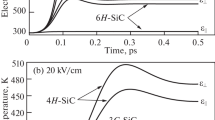For one production segment of designing semiconductor materials with given electrophysical properties, computer simulation of a number of basic technological physicochemical processes has been performed. With the use of high-resolution algorithms, the dynamics of thermal oxidation of the base material (silicon) and the evolution of the SiO2/Si and SiO2/O2 oxide film interfaces have been investigated. Simulation of the process of segregation of the acceptor and donor dopants (boron and phosphorus) in the base material at the SiO2/ Si oxidation wave front has been performed. For the “trench”-type geometry of the substrate surface, the distributions of boron and phosphorus concentrations have been obtained. It has been shown that the uniform (at the initial instant of time) distribution of dopant concentrations in the base material transforms to a distribution of narrowly-localized (of width about 65 nm) high-intensity peaks. Such nanostructures of donor and acceptor impurities in the substrate provide the required semiconductor electrophysical properties of the material.
Similar content being viewed by others
References
S. A. Pakhomov, Revolution in the production of transistors, Computer Press, No. 1, 76–83 (2004).
B. E. Deal and A. S. Grove, General relationship for the thermal oxidation of silicon, Appl. Phys., 36, 37–70 (1965).
C. P. Ho and J. D. Plumber, Si/SiO2 interface oxidation kinetics: a physical model of high substrate doping levels, J. Electrochem. Soc., 126, No. 9, 1516–1522 (1979).
A. Ya. Vul’, T. L. Makarova, V. Yu. Osipova, Yu. S. Zinchik, and S. K. Boitsov, Kinetics of silicon oxidation and the structure of oxide layers of thickness less than 50 Å, Fiz. Tekh. Poluprovodn., 26, No. 1, 111–121 (1992).
V. Senez, P. Fereiza, and A. Baccus, Two-dimensional simulation of local oxidation of silicon: calibrated viscoelastic flow analysis, IEEE Trans. Elec. Dev., 43, No. 5, 720–731 (1996).
V. Romano, 2D simulation of a silicon MESFET with a nonparabolic hydrodynamical model based on the maximum entropy principle, J. Comput. Phys., 176, No. 1, 70–92 (2002).
A. M. Blokhin, R. S. Bushmanov, and V. Romano, Asymptotic stability of the equilibrium state for the hydrodynamical model of charge transport in semiconductors based on the maximum entropy principle, Int. J. Eng. Sci., 42, No. 8–9, 915–934 (2004).
A. L. Aleksandrov, G. A. Tarnavskii, S. I. Shpak, A. S. Gulidov, and M. S. Obrekht, Numerical simulation of the problem of the dynamics of oxide film growth in semiconductor substrates on the basis of the geometric approach and the Deal-Grow method, Vychisl. Metody Programmir., 2, No. 1, 92–111 (2001).
G. A. Tarnavskii, S. I. Shpak, and M. S. Obrekht, Numerical simulation and computer algorithm of the process of segregation of dopants at the oxidation wave boundary in semiconductor substrates, Vychisl. Metody Programmir., 2, No. 1, 12–26 (2001).
G. A. Tarnavskii, S. I. Shpak, and M. S. Obrekht, Segregation of boron implanted in silicon on angular configurations of the silicon/silicon dioxide oxidation wave, Pis’ma Zh. Éksp. Teor. Fiz., 73, No. 9–10, 536–541 (2001).
G. A. Tarnavskii, S. I. Shpak, and M. S. Obrekht, Features of the segregation of dopants of V(a) subgroup elements on angular configurations of the silicon/silicon dioxide oxidation boundary, Inzh.-Fiz. Zh., 75, No. 1, 142–147 (2002).
G. A. Tarnavskii, A. V. Aliev, and A. G. Tarnavskii, Mathematical modeling of the processes of formation of nanostructures of dopants in the base material (nanotechnologies for microelectronics), Sib. Zh. Vychisl. Mat., No. 4, 401–416 (2007).
G. A. Tarnavskii, A. V. Aliev, and A. G. Tarnavskii, Creation of special nanostructures of donor and acceptor impurities in the base silicon substrate for designing new semiconductor materials, Nano-Mikrosist. Tekh., No. 9, 2–7 (2007).
G. A. Tarnavskii, A. V. Aliev, and A. G. Tarnavskii, Formation of nanostructures of donor and acceptor impurities upon annealing of the base silicon substrate, Nanotekhnika, No. 4 (12), 53–58 (2007).
Author information
Authors and Affiliations
Corresponding author
Additional information
Translated from Inzhenerno-Fizicheskii Zhurnal, Vol. 81, No. 5, pp. 994–1004, September–October, 2008.
Rights and permissions
About this article
Cite this article
Tarnavskii, G.A. Design of semiconductor materials for electronics. Segment of the technological process: Annealing of the base substrate and formation of a nanostructure of dopants. J Eng Phys Thermophy 81, 1038–1049 (2008). https://doi.org/10.1007/s10891-009-0105-0
Received:
Revised:
Published:
Issue Date:
DOI: https://doi.org/10.1007/s10891-009-0105-0




